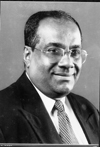|
|
||||
|
Of silk and ermine
I remember the young man, dark in aspect, overconfident in attitude, brash in style, electric in the spread of vibes, speeding along the streets of Colombo, in his red and somewhat-battered Karman Ghia, as if he were in a hurry to reach some indeterminate destination.
Some thirty five years later, he had sped, with the same expediency with which he piloted his Karman Ghia, from an obscure teaching temple in Rosmead Place, where he read the alphabet of law, to the inner sanctum of the apex temple of justice on St. Sebastian Hill. Here on July 7, he will respond to the traditional injunction issued forth by a Ceremonial Bench of the Supreme Court, “Do you move, Hemantha Warnakulasuriya?”, and then take his seat in the Inner Bar, decked in silk and ermine. Warnakulasuriya is not the traditional stuff of
silk and ermine. At age 19 he was the President of the All Ceylon Lorry Owners’ Association that thrust upon him, at such an impressionable age, qualities of leadership, toughness of resolve and muscle and moral intrepidity that stood him in good stead in the pursuit of a career that he was later to choose. Warnakulasuriya enthused in the traditions of art, culture, drama and mores of the deep South, to which disciplines he was naturally heir, and he was in the thick of the thriving dramatic revival of the time, at or about which he left school. Royal College could not succeed in dampening Warnakulasuriya’s inherent enthusiasm in things traditional and cultural. Straight from school he joined ‘Ape Kattiya’ that the enormously talented Sugathapala de Silva founded, and was one of the leading ‘dramatis personae’ in “Harima Badu Hayak”. Warnakulasuriya wrote extensively on all manner of things that spoke to the conscience of the nation. He wrote with affection of Wickramasinghe, Sarachchandra and Amarasekera. He wrote with sensitivity on “Maname” and “Sinhabahu”. He wrote with anger on the banning of “Aksharaya”. He wrote with indignation of the murder of Liyanarachchi and the rape of Inoka Gallage. He wrote with Freudian-depth of pornography in art and literature. He wrote with sadness on the declining standards of legal practice, and with compassion on the ill-equipped young lawyers struggling at the Bar. He wrote with Cardusian authority on Jayasuriya’s sweep, and Muralitharan’s ‘Gorgia Pasha’ deliveries. Warnakulasuriya was often the keeper of the judicial conscience of the nation, which he demonstrated now and then by his court appearance-instituted ‘pro dep’ and his wide ranging writings in The Sunday Times. When Liyanarachchi, the fundamental rights lawyer, was killed at the instance of the Police, the Bar Association met in emergency sessions. At this meeting, Warnakulasuriya moved a resolution to the effect that no lawyer should appear for the Police in any Court, and in any case until those policemen responsible for the Liyanarachchi murder were arrested and charged. The Warnakulasuriya resolution was carried with near unanimity, and the Police accused in the Liyanarachchi murder case had to import legal assistance from London to defend them at the eventual trial. Warnakulasuriya made a singular impact as an administrator in several pivotal bar-related bodies of our country. As member and Chairman of the Legal Aid Commission and later the Chairman of the Legal Aid Foundation, for almost a decade running, Warnakulasuriya organised dispensation of aid to impoverished litigants, a duty close to his heart’s desire. As Secretary and Deputy President of the Bar Association, Warnakulasuriya put in place many innovations for the imparting of legal education among new entrants to the Bar. To facilitate this process Warnakulsuriya made the Newsletter, a monthly publication and the Nithi Neethi Igenuma. For all this and more, the investiture of silk and ermine on Warnakulasuriya is not a mere decoration of cosmetic superficiality, with which such conferment is generally associated in the perception of the informed public. This investiture evolved and blended with the life and times of Warnakulasuriya and constitutes some many splendorous design embroidered into the tapestry of his career. I have in my Chambers a bronze replica of the ‘Dance of Siva’ gifted to me by the great Sam Kadiragamar, QC, in whose Chambers I spent some of the happiest years of my life, honing the sophistications and refinements of Industrial Law. The figure has two legs and four hands, one hand carries a flame, the other, a drum; the third makes a gesture; and the fourth points to the foot, which is seen trampling a dwarf. The ‘Dance of Siva’ would appear to suggest the infinite variety of Warnakulasuriya’s life and times, holding aloft the flame of practical justice and the drum depicting fondness for art, craft and culture, trampling the dwarfs of inequity, and yet maintaining a delicate balance poised on one foot and promising assistance of material and moral aid with his suspended arm! “Do you move, Hemantha Warnakulasuriya?” The writer is an Attorney-at-Law |
||||
Copyright © 2006 Wijeya Newspapers
Ltd. All rights reserved. |
